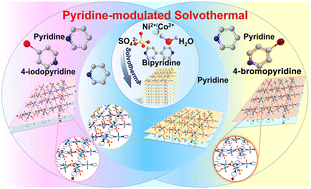Surface-halogen-introduced 2D NiCo bimetallic MOFs via a modulation method for elevated electrochemical glucose sensing†
Abstract
Two-dimensional (2D) metal–organic frameworks (MOFs) have been regarded as promising materials for electrochemical sensing, although plenty of efforts need to be devoted to enhancing their electrochemical performance. Herein, we have synthesized 2D NiCo bimetallic MOF nanoplates through a pyridine-modulated solvothermal synthesis and used 4-halogenpyridine for surface functionalization to overcome the shortcomings of the original MOFs. The 2D MOF nanoplates exhibit larger surface areas and higher densities of active sites than the cuboid structure. Besides, surface halogenation can improve the structural stability, generate more active sites, and enhance the interaction strength between MOFs and glucose (GLU). Specifically, the as-synthesized NiCoBP-Br exhibits excellent electrocatalytic performance for GLU with a quick response time of less than 2 s, and a high sensitivity of up to 1755.51 μA mM−1 cm−2 is achieved in the range of 0.5–6065.5 μM. This work will contribute to the evolution of MOF-based electrocatalysts and the improvement of their performance in electrochemical sensing.



 Please wait while we load your content...
Please wait while we load your content...